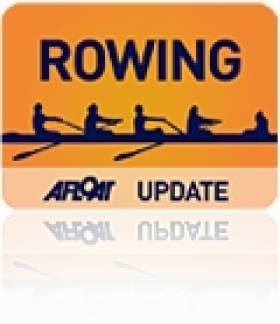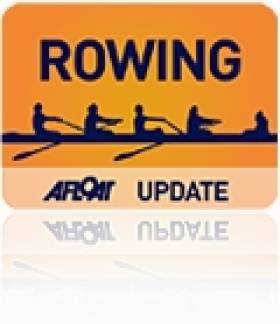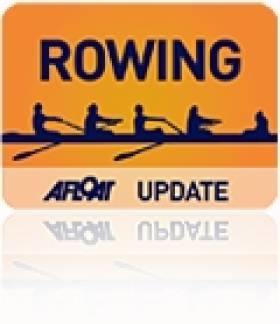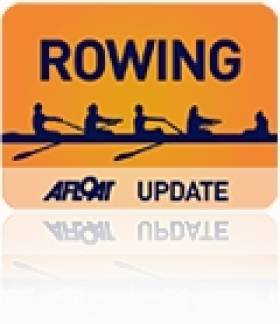Displaying items by tag: Sanita Puspure
In-Form Puspure Makes Second Successive Championship Final
#ROWING: Ireland’s Sanita Puspure qualified for her second successive championship final by finishing third in her semi-final at the World Cup regatta in Aiguebelette in France. Emma Twigg of New Zealand, who won gold at the first World Cup regatta in Sydney, won this sem-final convincingly, with Genevra Stone of the United States and Puspure taking the other A Final qualification spots. Puspure started well and led early on. When Stone came through she and Stone swapped second and third, staying clear of the rest of the field.
World Cup Regatta, Aiguebelette, France, Day Two (Selected Results, Irish interest)
Men
Single Sculls – D Final (Places 19 to 23): 1 Bulgaria 7:14.01, 2 Ireland (J Keohane) 7:16.48, 3 China 7:19.41.
Lightweight Single Sculls – Semi-Final Two (First Three to A Final; rest to B Final): 1 Germany Two (J Schoemann-Finck) 7:00.71, 2 Bulgaria (V Nedelcho) 7:03.69, 3 France (D Piqueras) 7:04.23; 4 Ireland One (P O’Donovan) 7:06.99, 5 Switzerland One 7:14.8, 6 Algeria 7:21.36. C Final (places 13 to 18): 1 Ireland Two (M O’Donovan) 7:17.11, 2 Tunisia One 7:17.40, 3 Switzerland Two 7:19.58.
Women
Pair – A/B Semi-Final One (First Three to A Final; rest to B Final):
1 United States Three (V Opitz, M Musnicki) 7:02.27, 2 United States One (M Kalmoe, K Simmonds) 7:02.33, 3 United States Four (A Polk, L Schmetterling) 7:04.23; 4 Canada 7:07.94, 5 Ireland (L Kennedy, L Dilleen) 7:16.80, 6 France 7:32.46.
Double Sculls – C Final (Places 13, 14): 1 France 7:12.84, 2 Ireland (M Dukarska, E Moran) 7:20.78.
Lightweight Double Sculls – A/B Semi-Final One (First Three to A Final; rest to B Final): 1 Britain (I Walsh, K Copeland) 7:05.84, 2 China One (Tianyu Teng, Wenyi Huang) 7:07.25, 3 Sweden (C Lilja, E Fredh) 7:08.90; 4 Australia 7:13.07, 5 China Two 7:13.17, 6 Ireland (C Lambe, D Walsh) 7:14.79.
Single Sculls – A/G Semi-Final Two (First Three to A Final; rest to B Final): 1 New Zeland (E Twigg) 7:27.30, 2 United States (G Stone) 7:33.02, 3 Ireland (S Puspure) 7:33.79; 4 Germany 7:38.42, 5 Switzerland 7:42.76, 6 France 7:44.20
Pararowing: ASM1X - B Final: 4 Ireland (T Kelly) 5:42.41.
Rowing Pair of Dilleen and Kennedy Make Mark at Trials
#ROWING: The newly-formed women’s pair of Lisa Dilleen and Leonora Kennedy were outstanding in racing on the final day of the Ireland Trials at the National Rowing Centre. Their percentage of projected World Championship gold medal winning time was an excellent 88.25. The new lightweight men’s pair of Mark O’Donovan and Niall Kenny and single scullers Paul O’Donovan and Sanita Puspure also breached 87 per cent. All these crews are set to represent Ireland this year.
On Saturday, in the Home International Trials, Eimantas Grigalius, the former world junior champion for Lithuania who now lives in Ireland, topped the rankings in the single sculls.
Ireland Trials, National Rowing Centre, Cork
Saturday (Home International Trials)
Men
Pair – Senior: 1 Buckley/Coughlan 7:52.57 (74.06), 2 Rawlinson/Brett 7:53.86 (73.86), 3 Deere/Corcoran 7:57.32 (73.33).
Lightweight Pair: Keene/Breen 7:48.69 (74.68), 2 Murphy/McKenna 7:49.77 (74.5)
Junior Pair: 1 Browne/O’Connor 7:54.10 (73.82), 2 Higgins/Higgins 7:55.62 (73.59), 3 Coyne/McCarthy 7:57.33 (73.32).
Single Sculls – Senior: 1 E Grigalius 7:51.56 (78.46), 2 D Neale 7:59.09 (77.23), 3 S McKeown 8:04.84 (76.31).
Lightweight Single Sculls – Senior: N Duncan 8:21.96 (75.70), 2 C Murphy 8:41.5 (72.78), 3 S Toland 8:49.20 (71.81)
Junior Single Scull: 1 D Synott 8:04.76 (76.33), 2 S Dennehy 8:11.55 (75.27), 3 S O’Sullivan 8:12.87 (75.07).
Women
Pair - Senior: 1 Lonergan/Ryan 8:47.30 (73.58), 2 O’Brien/McCarthy 8:48.73 (73.38), 3 Bracken/Kelly 8:59.77 (71.88).
Lightweight Pair – Senior: 1 Leahy/Crowe 8:36.85 (77.78), 2 Wickham/Judge 8:51.01 (75.70).
Junior Pair: Connor/Hickey 8:44.08 (74.03), 2 Davis/O’Dwyer 8:51.97 (72.94), 3 O’Keeffe/Nagle 8:55.28 (72.49).
Lightweight Single Sculls – Senior: 1 E Desmond 9:18.30 (74.87), 2 O Holden 9:40.27 (72.04), 3 A Bulman 9:43.64 (71.62).
Junior Single Scull: 1 A Rodger 9:03.29 (73.99), 2 S Murphy 9:03.99 (73.9), 3 M McLaughlin 9:05.29 (73.72).
Sunday
(Per Centages Based On Senior Times)
Race One: 1 B Keohane, D Keohane (junior pair) 7:34.12 (81.04), 2 P O’Donovan (lightweight single, under-23) 7:37.78 (87.38), 3 L Kennedy, L Dilleen (women’s senior pair) 7:40.89 (88.25), 4 O Hayes, C Jennings (women’s lightweight double) 7:51.38 (85.71).
Race Two: 1 S Dolan (women’s lightweight single) 8:50.00 (83.02), S Horgan (women’s lightweight single, under-23) 8:51.63 (82.76), 3 E Barry (jun women’s single) 8:52.99 (79.74), 4 E Hegarty (jun women’s single) 9:06.59 (77.75)
Race Three: 1 J Ryan (lightweight single) 7:53.65 (84.45), 2 Women’s Junior Double (J English, E Lambe) 8:02.67 (81.63), 3 S Puspure (women’s single) 8:05.73 (87.5), 4 Women’s Junior Double (O’Keeffe) 8:16.75 (79.32).
Race Four: 1 Lightweight Pair (M O’Donovan, N Kenny) 7:15.87 (87.18), 2 Women’s Four (M O’Neill, E Tormey, B O’Brien, A Keogh) 7:31.87 (84.09), 3 D Neale (men’s single) 7:56.54 (81.84), 4 J Keohane (men’s single) 7:59.85 (81.28).
Race Five: 1 Men’s Double (S McKeown, D Quinlan) 7:12.90 (82.93), 2 Men’s Double (Oliver) 7:17.73 (82.01), 3 Men’s Pair (R O’Callaghan, R Bennett) 7:28.26 (82.10), 4 Men’s Pair (K Neville, M Pukelis) 7:31.51 (81.5).
Race Six: 1 Junior Quadruple (Begley) 6:58.49 (79.09), 2 Lightweight Double (C Beck) 7:11.04 (84.91), 3 Junior Double (D O’Malley, C Carmody) 7:12.49 (83.01), 4 Junior Double (Mulvaney) 7:19.14 (81.75).
Race Seven (Pararowing Crews, 1,000m): 1 LTA1x (O’Hara) 2:09.42 (77.27), 2 TA1x (O’Brien) 2:45.40 (81.62), 3 AS1x (O’Doherty) 2:48.06 (81.82), 4 AS1x (Kelly) 3:09.52 (72.55).
Ireland Rowers O'Donovan, McCrohan and Puspure Excel in Trial
#ROWING: On a day with a spread of excellent performances, Paul O’Donovan, Siobhán McCrohan and Sanita Puspure topped the rankings in their classes at the Ireland trial on Newry Canal. O’Donovan, a 19-year-old lightweight sculler, was the fastest man on the day. He clocked 19 minutes 5.46 seconds for the five kilometres, which made him the fourth fastest crew, only bettered by three heavyweight pairs.
McCrohan’s return was also remarkable. The Galway lightweight, who was cut by the previous Ireland coaching regime, shaded O’Donovan in terms of per centage of projected world gold medal time, with a superb 87.43 per cent. Puspure, a heavyweight sculler who had a 2013 to forget because of injury, also excelled, with 86.99 per cent despite a brush with a tree and hitting a buoy in the headwind conditions.
Both men’s and women’s lightweight classes could boast a depth in good performances: Catríona Jennings, a former Olympian marathon runner who is new to rowing, reaced 86.26 of projected world best time as a lightweight sculler. Heavyweight sculler Monika Dukarska also performed well in finishing second to Puspure.
Ireland Trial, Newry, Saturday (Run over 5km; Selected Results)
(Percentage is of projected world gold medal winning time)
Men
Pair – Senior: 1 D Neale, C Folan 18 minutes 41.53 seconds (82.03), 2 D Power, P O’Connell 18:53.62 (81.6). Under-23: 1 R O’Callaghan, R Bennett 18:29.53 (82.92), 2 M Pukelis, K Neville 19:23.43 (79.08). Junior: D Keohane, B Keohane 19:06.58 (80.24), 2 Murphy, O’Connell 19:26.23 (78.89), 3 Fallon, Bennett 19:32.47 (78.47).
Lightweight: 1 Quinlan, O’Connor 19:27.59 (81.36), 2 McKenna, Murphy 19:30.72 (81.15), 3 Keane, Breen 19:32.55 (81.02).
Sculling,
Single – Senior: 1 J Keohane 19:16.47 (84.31), 2 A McEvoy 19:37.34 (82.81). Under-23: 1 T Oliver 19.47.82 (82.08), 2 A Harrington 19:52.47 (81.76), 3 S McKeown 20:06.03 (80.84). Junior: 1 D O’Malley 19:41.55 (82.5), 2 C Carmody 19:57.29 (81.43), 3 C Hennessy 20:15.6 (80.21).
Lightweight – Senior: 1 N Kenny 19:18.40 (86.33), 2 J Ryan 19:28.13 (85.61), 3 M O’Donovan 19:30.07 (85.46). Under-23: P O’Donovan 19:05.46 (87.3), 2 S O’Driscoll 19:26.18 (85.75), 3 C Beck 19:41.35 (84.65).
Women
Four – Senior: Deasy, McCarthy, O’Brien, Leahy 19:51.76 (84.33).
Pair – Senior: L Dileen, A Keogh 20:12.32 (84.14), 2 Bennett, Gilligan 21:28.79 (79.14). Under-23: G Collins, O Finnegan 21.05.13 (80.62). Junior: 1 K O’Connor, H Hickey 21:43.08 (78.28), 2 Clarke, Glover 21:54.75 (77.58), 3 Nagle, O’Keeffe 22:33.06 (75.38).
Sculling
Single – Senior: 1 S Puspure 20:21.36 (86.99), 2 M Dukarska 2:40.57 (85.65), 3 E Moran 21:20.92. Under-23: 1 C Fitzgerald 21.50.12 (81.10), 2 H O’Sullivan 22:14.21 (79.64), 3 M Dineen 22:27.69 (78.84). Junior: 1 E Lambe 21:47.62 (81.25), 2 J English 21:54.17 (80.85), 3 E Barry 22:03.17 (80.30).
Lightweight – Senior: 1 S McCrohan 20:58.15 (87.43), 2 C Jennings 21:15.24 (86.26), 3 O Hayes 21:18.60 (86.03). Under-23: 1 R Morris 21:32.68 (85.09), 2 S Horgan 21:47.18 (84.15).
High Five for Rowers as Irish Sports Council Confirms Carding
#ROWING: A relatively good 2013 for Irish international rowing will bring practical benefits this year. Five rowers, three more than last year, will receive funding from The Irish Sports Council under the 2014 International Carding Scheme. Sanita Puspure and Claire Lambe have again hit the mark: Puspure qualifies for €20,000 as a world class category athlete and Lambe receives €12,000 as an international class competitor. The two are joined this year by Paul O’Donovan, Leonora Kennedy and Monika Dukarska, who will also be granted €12,000 as international class athletes.
O’Donovan won a medal at the World Under-23 Championships in 2013, while the women’s double sculls of Dukarska and Kennedy finished 10th at the World Championships. This position would secure Olympic qualification for an Ireland boat if it were reproduced at the World Championships next year.
Puspure Withdraws From European Rowing Semi-Final
# ROWING: Sanita Puspure was withdrawn from the A/B semi-final of the single sculls at the European Rowing Championships in Seville today. Ireland Performance Director, Morten Espersen said that the decision was made this morning because the 31-year-old had flu-like symptoms. Puspure was very unwell and could not race.
John Keohane finished fifth in his C Final, 17th overall, while the Ireland lightweight double of Niall Kenny and Justin Ryan finished 21st overall with third pace in the D Final behind Slovakia and the Czech Republic. In the C/D semi-final they were competitive early but lost out when the second half of the race became a scramble for second and third places behind dominant winners Hungary. Ireland struggled to deal with the head wind and finished fifth.
European Rowing Championships, Seville, Day Two (Irish interest)
Men
Single Sculls – C Final (places 13 to 18): 1 Hungary 7:56.08; 5 Ireland (J Keohane) 8:03.54.
Lightweight Double Sculls – C/D Semi-Finals Two (First Three to C Final; rest to D Final): 1 Hungary 7:15.12, 2 Slovenia 7:18.43, 3 Bulgaria 7:18.64; 4 Slovakia 7:20.27, 5 Ireland (N Kenny, J Ryan) 7:26.76. D Final (places 19 to 22): 1 Slovakia 7:20.10, 2 Czech Republic 7:20.44, 3 Ireland 7:25.26, 4 Armenia 8:59.40.
Women
Single Sculls – A/B Semi-Final One: Ireland (S Puspure) Did not start.
Two womens' boats will compete for Olympic qualification, another is seeking Paralympics qualification and two boats are entered in non-Olympic world championship events.
The boats with ambition for Olympic qualification are the lightweight double scull of Claire Lambe and Siobhan McCrohan and the openweight women's double scull of Sanita Puspure and Lisa Dilleen.
With lightweight double sculls being the only boat class for lightweight women, the entry of 26 boats will generate intense competition for the eight Olympic places on offer this year. Lambe and McCrohan, who came fourth at last year's European championships, will be competitive for one of these Olympic places, but it will be very tight with any mistakes or errors making a dramatic difference in final results.
Similarly the openweight women's double scull has eight Olympic places on offer with 19 entries. The newly formed double scull is a partnership between Dilleen, a 20 year old from Galway, who came fourth in the World Junior Rowing Championships two years ago; and Sanita Puspure, a recently naturalised Irish citizen from Latvia. In 2003, Puspure was a bronze medallist for Latvia at under 23 level. The Irish pair finished fifth at the first World Cup earlier this summer in Munich, followed by an eleventh place in Lucerne.
For the first time, Ireland has a boat attempting qualification for next year's London Paralympic games in the form of a mixed coxed four crew in the legs, trunk, and arms (LTA) category. There are 16 entries with 8 qualifying. Ireland's boat finished fifth at the 2010 World Rowing Championships, and whilst the number of entrants has increased this year, the crew have a good chance of making the first eight to qualify.
Performance director Martin McElroy, an Olympic gold medal winning coach with the British team at the Sydney Olympics in 2000, said today, "Only our adaptive athletes went to the 2010 World Rowing championships. For all the others competing, it's a first time experience, and in an Olympic qualification year that's a big ask."
"When I started in my role as performance director in 2009, I knew we were missing a generation of athletes. A look at the age demographic of our team confirms that. However I am very pleased that we have a young ambitious group of athletes who are willing to take it on and it is not beyond the bounds of possibility that one or more of the boats may qualify. It's a big ask but it's not impossible. Added to that, we have a Paralympic boat seeking qualification for the first time"
The men's lightweight quadruple scull contains the same line-up that won a silver medal at the 2010 World Under-23 Rowing Championships. A strategic decision was taken to favour the non-Olympic boat class for these young athletes in order to continue their international development.
Performance director, Martin McElroy explained, "The choice was to risk immersing these young athletes in the cauldron of Olympic lightweight class boats which are amongst the most competitive classes in the Olympic regatta and create a very negative experience early in their careers, or take a more measured approach to their development and transition to the senior level through the non-Olympic boat classes."
"It was clear to us that we did not have a boat that would be close to qualification at this time and we discussed this openly with the squad. With 34 entries and only 11 to qualify, I'm satisfied that we've taken the right decision. These young athletes can compete positively in the quadruple scull event and continue taking the steps necessary to transition successfully from under 23 to senior."
Sarah Dolan a 21-year old Trinity college engineering student races in the women's lightweight single scull, an event with 22 entries.
Rower of the Month: Sanita Puspure Podcast
The Afloat Rowers of the Month for May, Sanita Puspure and Lisa Dilleen, showed how a new crew can knit together successfully: their first three results as a double scull were third, second and fifth – in the heats, semi-finals and finals at the World Cup regatta in Munich! Listen to Sanita Puspure talk about this on the Afloat Podcast (two minutes duration) here.






























































